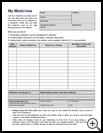
Bronchodilator: Anticholinergic
________________________________________________________________________
KEY POINTS
- Anticholinergic bronchodilators are medicines used to treat breathing problems caused by asthma.
- They are taken every day, even when your child is not having symptoms. They do not give quick relief in acute asthma attacks.
- Make sure you know how and when your child needs to take the medicine. Your child should not take more or less than he or she is supposed to take.
- Ask your healthcare provider or pharmacist what side effects the medicine may cause, and what you should do if your child has side effects.
________________________________________________________________________
What is this medicine used for?
Anticholinergic bronchodilators are medicines used to treat breathing problems caused by asthma. This medicine is called a controller medicine because when it is taken regularly every day, it helps to control symptoms.
Anticholinergic medicine used alone does not treat sudden, severe breathing problems. It does not give quick relief of wheezing in acute attacks. For acute attacks, your child needs a different type of medicine called a rescue inhaler.
Sometimes this medicine is combined with other types of breathing medicine to treat sudden symptoms. It is also used when your child cannot take other types of medicine to help with breathing.
Asthma symptoms are caused by two different problems in the airways:
- One problem is that the tiny muscles around the airways tighten up, which causes shortness of breath, coughing, wheezing, and sometimes chest tightness.
- The other problem is redness, swelling, irritation, and too much mucus in the airways.
If your child has asthma, symptoms often start after your child is exposed to a trigger. Asthma triggers can include:
- Exercise and other physical activity
- Allergies such as dust, pollen, mold, or animal dander
- Something that irritates the lungs such as cold air, smoke, or strong smells such as paint, soap, candles, or perfume
- Nonsteroidal anti-inflammatory medicines (NSAIDs) such as aspirin, ibuprofen, and naproxen
- An infection such as a cold, the flu, or a sinus infection
- Strong emotions or stress
- Indigestion or heartburn, also called gastroesophageal reflux disease, or GERD. If your child often has problems with indigestion you may have more asthma symptoms, especially while lying down.
Try to limit your child’s contact with these triggers, especially in places where your child spends a lot of time such as at home and school or work. Your child should keep a rescue inhaler with him or her at all times in case your child has an asthma attack.
Asthma symptoms come and go throughout the day or week and get better with medicine.
How does it work?
Anticholinergic medicines help breathing problems because they block one of the chemicals in the body that make your child’s airway muscles tight. When the airway muscles are more relaxed and less tight, your child will have fewer symptoms and be able to breathe better. Anticholinergic medicine also lowers the amount of mucus made in the airways. Anticholinergic controllers are also called long acting muscarinic antagonists (LAMAs).
The medicine can be taken in different ways. For example:
- A hand-held device, such as a metered-dose inhaler (MDI) or a dry powder inhaler, is small and easy to carry. Inhalers help send the medicine directly to your child’s lungs as your child takes a deep breath. Some inhalers may need a spacer. A spacer is a small tube or bag that holds the medicine while your child breathes it in to the lungs.
- A nebulizer is an electrically powered machine that your child can use at home, or if battery operated, anywhere. Medicine is mixed with liquid and the machine forms a mist. Your child breathes in the mist to help get the medicine in to the lungs.
What else do I need to know about this medicine?
- Follow the directions that come with your child’s medicine, including information about food. Ask for written information to take home. Tell your healthcare provider or pharmacist if you need information in a different language or larger type.
- Make sure you know how and when your child needs to take the medicine. Your child should not take more or less than he or she is supposed to take.
- Try to get all of your child’s prescriptions filled at the same place. Your pharmacist can help make sure that all of your child’s medicines are safe to take together.
- Keep a list of your child’s medicines with you. Tell your child's healthcare provider and pharmacist about all the prescription and nonprescription medicines, natural remedies, vitamins, and supplements your child takes.
- Many medicines have side effects. A side effect is a symptom or problem that is caused by the medicine. Ask your healthcare provider or pharmacist what side effects the medicine may cause and what you should do if your child has side effects.
If you have any questions, ask your healthcare provider or pharmacist for more information. Be sure to keep all appointments for provider visits or tests.
Last modified: 2022-01-03
Last reviewed: 2021-06-15

